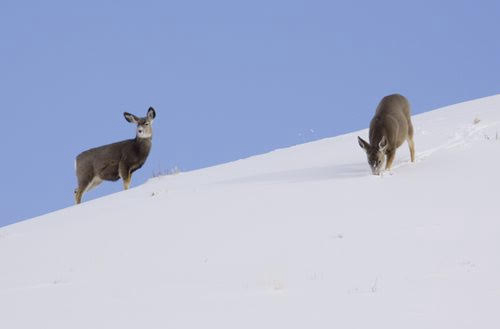DNR monitoring Upper Peninsula snow depths, assessing impact on deer herd
After receiving heavy snowfall across much of Michigan’s Upper Peninsula this week, the Department of Natural Resources is monitoring snow depths and assessing potential impacts on wildlife, particularly the deer herd which is still recovering from the two previous severe and snowy winters.
Supplemental feeding of deer is allowed on private land in the northern U.P. counties along Lake Superior each year beginning in early January and in the southern counties if accumulated snowfall meets established minimum depths by mid-January. However, if snow depths continue to rapidly climb this winter and exceed the supplemental feeding triggers before the January dates, the DNR will consider taking emergency action to allow feeding at an earlier date.
“With more than 20 inches of snow already on the ground in some of the southern U.P. counties and more than 40 inches reported in some northern locations, we are looking at ways to mitigate potential detrimental impacts of the early and significant snowfall on the deer herd,” said DNR Wildlife Division Chief Russ Mason.
According to Mason, the DNR’s Wildlife and Forest Management divisions are also evaluating current timber sale contracts to identify opportunities to retain tree tops at logging sites on public land for deer to forage on throughout the winter.
Private landowners who wish to help in these efforts are encouraged to begin cutting next year’s firewood now and leaving the downed trees as forage and cover for deer and other wildlife.
The recreational feeding of wildlife is also allowed on private land in the Upper Peninsula year-round, provided the feed is placed within 100 yards of a residence and the total amount of feed does not exceed two gallons at any time. The feed must be scattered on the ground and must be at least 100 yards from areas accessible by livestock.
“While recreational and supplemental feeding is typically done by well-intentioned citizens, it is important that all rules and regulations are followed to avoid unintended negative consequences, such as the spread of disease in the herd,” said Ashley Autenrieth, the DNR’s northern Michigan deer specialist. “Our ultimate goal is to support the deer herd through improving habitat and the availability of natural food sources, but in times of prolonged, severe weather conditions we understand many citizens will want to provide supplemental food to deer.”
Easily digestible food sources most beneficial for feeding deer include grains, second-cut alfalfa, clover, and pelletized deer food. Although deer make use of apples, potatoes, sugar beets, carrots, and many other foods during summer and fall, these provide little benefit for deer during winter conditions and are not legal for supplemental feeding under permits.
Supplemental deer feeding dates/criteria:
The supplemental feeding of deer on private land in the Upper Peninsula is subject to the following dates and criteria, unless an emergency feeding order is issued by the DNR’s Director:
In Ontonagon, Houghton, Keweenaw, Baraga, Alger, Luce and Gogebic counties, and in the northern portions of Marquette and Chippewa counties (north of the T43N-T44N boundary line), permits are issued annually to allow supplemental feeding of deer from the Monday following Jan. 1 (Jan. 5, 2015) through May 15.
In Iron, Dickinson, Delta and Menominee counties, and the southern portion of Marquette County (south of the T43N-T44N boundary line), permits are issued to allow supplemental feeding on private land if the total accumulated snow reported by the Crystal Falls and Escanaba Field Offices on the Monday nearest Jan. 15 reaches an average of 48 inches. Then, feeding may take place from the Monday nearest Jan. 15 (Jan. 19, 2015) through May 15.
In Schoolcraft and Mackinac counties, and the southern portion of Chippewa County (south of the T43N-T44N boundary line), permits are issued to allow supplemental feeding on private land when the total accumulated snow reported by the Manistique and Naubinway Field Offices on the Monday nearest Jan. 15 reaches an average of 60 inches. Then, feeding may take place from the Monday nearest Jan. 15 (Jan. 19, 2015) through May 15.






